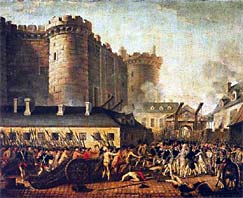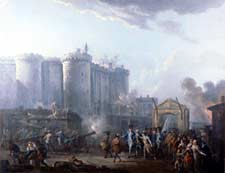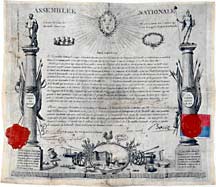| |
| |
|
| |

Prise de la Bastille
by Jean-Pierre-Louis-Laurent Hoüel |
| |
The Bastille Is Stormed
The insurgents invaded the Hôtel des Invalides to gather arms, and then attacked the Bastille. At this point, the jail was nearly empty, housing only seven inmates: four forgers, two "lunatics" and one "deviant" aristocrat, the Comte de Solages. The attackers were mainly seeking to acquire the large quantities of arms and ammunition stored there — on the 14th there were over 13,600 kg (30,000 lb) of gunpowder stored at the Bastille. The garrison, reinforced on the 7th, consisted of just 32 men of the Salis-Samade regiment together with 82 other staff and guards. The walls mounted eighteen eight-pound guns and twelve smaller pieces. The governor was Bernard-René de Launay, son of the previous governor and actually born within the Bastille.
The list of vainqueurs de la Bastille has around 600 names and the total of the crowd was probably less than a thousand. The crowd gathered outside around mid-morning, calling for the surrender of the prison, the removal of the guns and the release of the arms and gunpowder. Two deputies were invited into the fortress and negotiations began, another deputy was admitted around noon with definite demands. While the negotiations dragged on, the crowd grew in size and also became impatient.
Around 13:30 the crowd surged into the undefended outer courtyard and the chains on the drawbridge to the inner courtyard were cut — crushing one unfortunate vainqueur. About this time gunfire began; which side fired first will never be absolutely decided. The crowd seems to have felt it had been 'tricked', or drawn into a trap; the fighting became more intense and attempts by deputies to organise a cease-fire were ignored by the attackers.
| |
|

L'arrestation du gouverneur de
la Bastille, le 14 juillet 1789
by Jean-Baptiste Lallemand
1790-1795
Musée historique de la
Révolution française, Vizille |
|
| |
The firing continued and at 15:00 the attackers were reinforced by gardes françaises and other veterans carrying weapons taken from the Invalides earlier in the day, and also two cannons. With the possibility of a mutual massacre suddenly apparent, Governor de Launay ordered a cease fire at 17:00. A letter offering his terms was stuck through a gap in the inner gates and acrobatically retrieved by the besiegers. The demands were refused, but de Launay capitulated because he realized that his troops could not hold out much longer. He opened gates to the inner courtyard, and the vainqueurs swept in to liberate the fortress at 17:30.
Ninety-eight attackers had died, while only one defender perished. De Launay was seized and dragged towards the Hôtel de Ville in a storm of abuse. Outside the Hôtel a discussion as to his fate began, and following a particularly unpleasant suggestion from a man called Desnot, de Launay shouted "Enough! Let me die!" — kicking Desnot in the groin. De Launay was instantly and repeatedly stabbed, falling to the ground. His head was then sawed off and fixed on a pike to be carried through the streets. Returning to the Hôtel de Ville, the mob accused the prévôt des marchands (roughly, mayor) Jacques de Flesselles of treachery; en route to an ostensible trial at the Palais Royal, he was assassinated.
Aftermath
| |
|
| |

Diplôme de Vainqueur de la Bastille (1790).
Decree from the National Assembly, praising those who stormed the Bastille. |
| |
The citizenry of Paris, expecting a counterattack, entrenched the streets, built barricades of paving stones, and armed themselves as well as they could, especially with improvised pikes. Meanwhile, at Versailles, the Assembly remained ignorant of most of the Paris events, but eminently aware that Marshal de Broglie stood on the brink of unleashing a pro-Royalist coup to force the Assembly to adopt the order of June 23 and then to dissolve. The Viscount de Noailles apparently first brought reasonably accurate news of the Paris events to Versailles. M. Ganilh and Bancal-des-Issarts, dispatched to the Hôtel de Ville, confirmed his report.
By the morning of July 15 the outcome appeared clear to the king as well, and he and his military supporters backed down, at least for the time being. The Marquis de Lafayette took up command of the National Guard at Paris; Jean-Sylvain Bailly — leader of the Third Estate and instigator of the Tennis Court Oath — became the city's mayor under a new governmental structure known as the commune. The king announced that he would recall Necker and return from Versailles to Paris; on July 27, in Paris, he accepted a tricolor cockade from Bailly and entered the Hôtel de Ville, as cries of "Long live the Nation" changed to "Long live the King".
Nonetheless, after this violence, members of the nobility — who were little assured by the apparent and, as it was to prove, temporary reconciliation of king and people — started to flee the country as émigrés. Early émigrés included the comte d'Artois (the future Charles X of France) and his two sons, the prince de Condé, the prince de Conti, the Polignac family, and (slightly later) Charles Alexandre de Calonne, the former finance minister. They settled at Turin, where Calonne, as agent for the count d'Artois and the prince de Condé, began plotting civil war within the kingdom and agitating for a European coalition against France.
Necker returned from Basel to Paris in triumph (which proved short-lived). He discovered upon his arrival that the mob had cruelly murdered Foulon and Foulon's nephew, Berthier, and that the baron de Besenval (commander under de Broglie) was held prisoner. Wishing to avoid further bloodshed, he overplayed his hand by demanding and obtaining a general amnesty, voted by the assembly of electors of Paris.
In demanding amnesty rather than merely a just tribunal, Necker misjudged the weight of the political forces. He overestimated the power of the ad hoc assembly, which almost immediately revoked the amnesty to save their own role, and perhaps their own skins, instituting a trial court at Châtelet. Mignet counts this as the moment when the Revolution left Necker behind.
The successful insurrection at Paris spread throughout France. People organized themselves into municipalities for purposes of self-government, and into bodies of national guards for self-defense, in accord with principles of popular sovereignty and with complete disregard for claims of royal authority. In rural areas, many went beyond this: some burned title-deeds and no small number of châteaux.
Historical Assessment
Many historians believe that the storming of the Bastille was more important as a rallying point and symbolic act of rebellion than any practical act of defiance. No less important in the history of France, it was not the image typically conjured up of courageous French patriots storming a towering fortress and freeing hundreds of oppressed peasants. This myth-making began on July 17, 1789 with the publication of the Révolutions de Paris — which offered a colorful rendition of the attack and an entirely false description of the many prisoners freed.
Fictional Accounts
An historical fiction account of the storming of the Bastille can be found in A Tale of Two Cities by Charles Dickens.
GO TO NEXT PAGE »
Demolition of the Fortress
|
|

